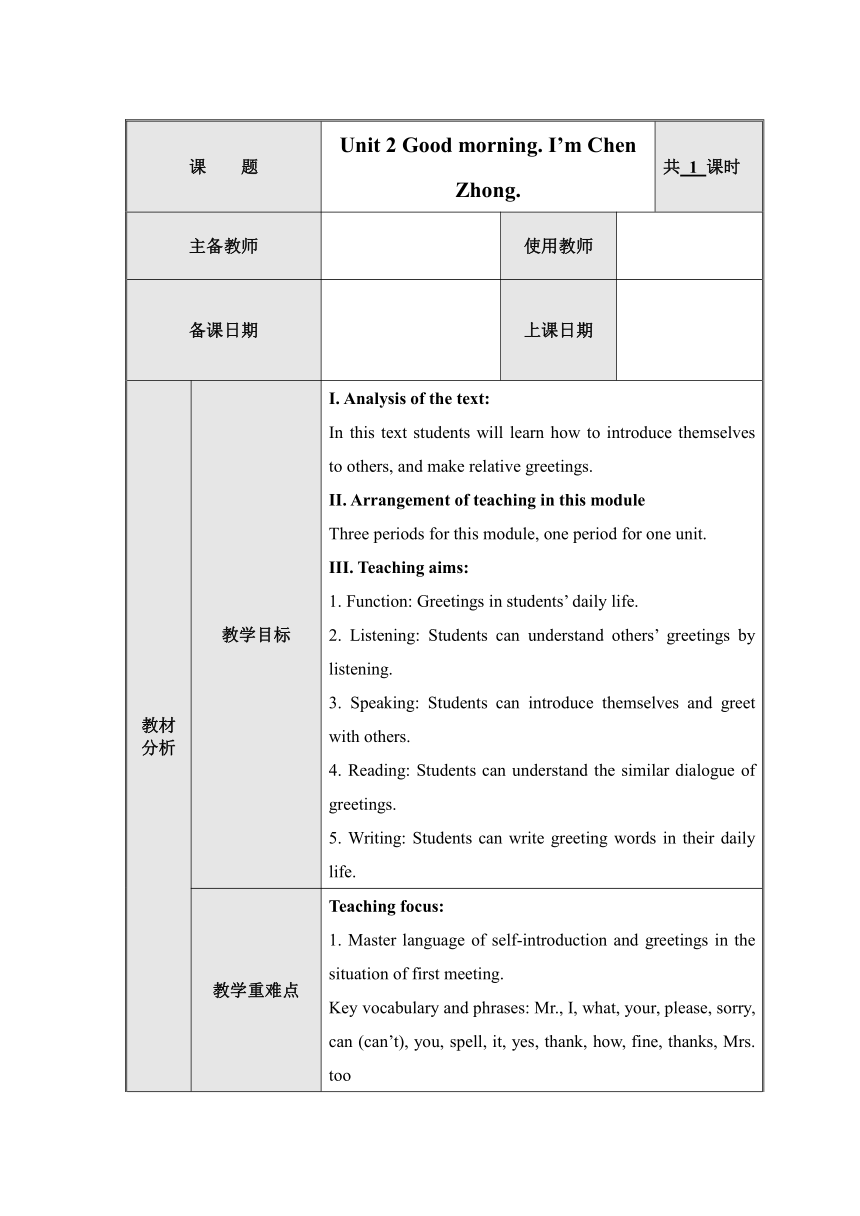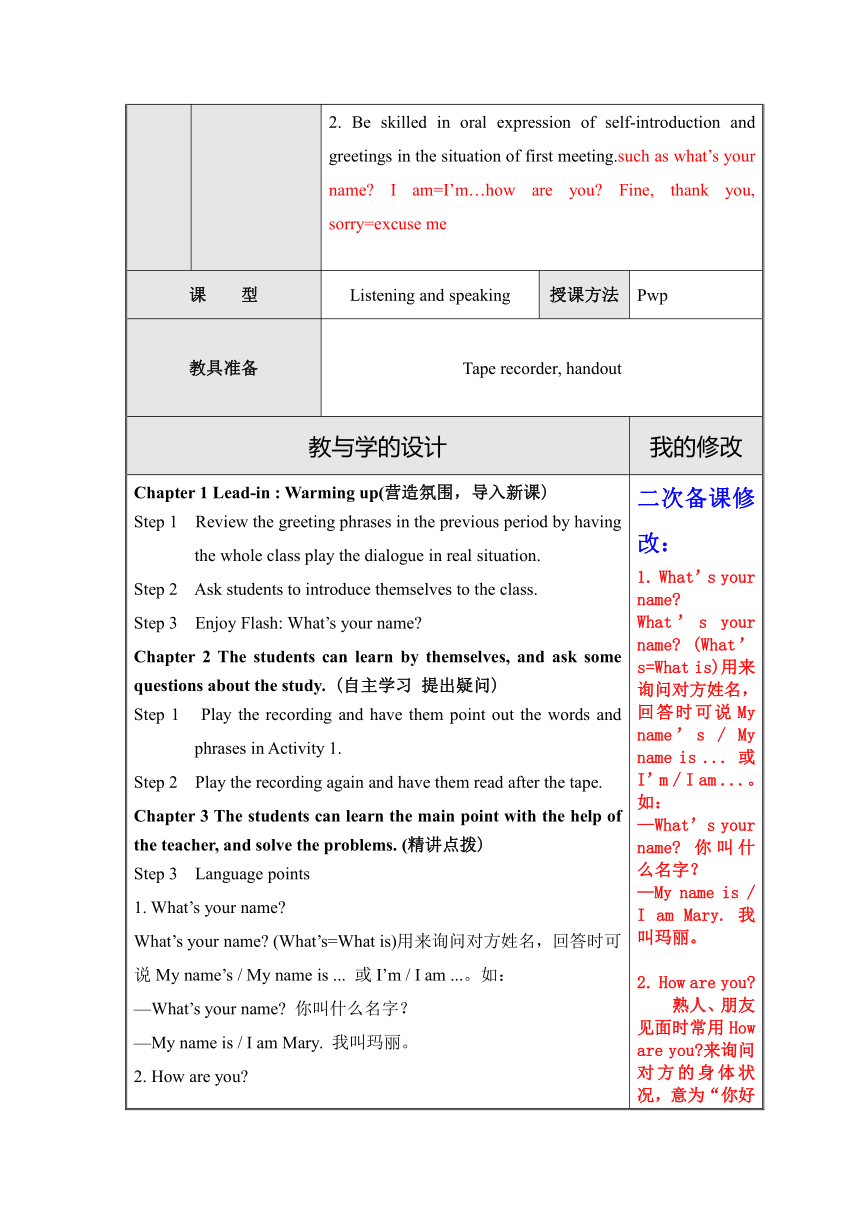Starter Module 1 My teacher and my friends Unit 2 Good morning. 教案
文档属性
| 名称 | Starter Module 1 My teacher and my friends Unit 2 Good morning. 教案 |  | |
| 格式 | zip | ||
| 文件大小 | 14.0KB | ||
| 资源类型 | 教案 | ||
| 版本资源 | 外研版 | ||
| 科目 | 英语 | ||
| 更新时间 | 2015-09-23 20:24:29 | ||
图片预览



文档简介
PAGE
电子教案
年级:
学科:
教师:
课 题 Unit 2 Good morning. I’m Chen Zhong. 共 1 课时
主备教师 使用教师
备课日期 上课日期
教材分析 教学目标 I. Analysis of the text:In this text students will learn how to introduce themselves to others, and make relative greetings.II. Arrangement of teaching in this moduleThree periods for this module, one period for one unit.III. Teaching aims:1. Function: Greetings in students’ daily life.2. Listening: Students can understand others’ greetings by listening.3. Speaking: Students can introduce themselves and greet with others.4. Reading: Students can understand the similar dialogue of greetings.5. Writing: Students can write greeting words in their daily life.
教学重难点 Teaching focus:1. Master language of self-introduction and greetings in the situation of first meeting.Key vocabulary and phrases: Mr., I, what, your, please, sorry, can (can’t), you, spell, it, yes, thank, how, fine, thanks, Mrs. too 2. Be skilled in oral expression of self-introduction and greetings in the situation of first meeting.such as what’s your name I am=I’m…how are you Fine, thank you, sorry=excuse me
课 型 Listening and speaking 授课方法 Pwp
教具准备 Tape recorder, handout
教与学的设计 我的修改
Chapter 1 Lead-in : Warming up(营造氛围,导入新课)Step 1 Review the greeting phrases in the previous period by having the whole class play the dialogue in real situation.Step 2 Ask students to introduce themselves to the class.Step 3 Enjoy Flash: What’s your name Chapter 2 The students can learn by themselves, and ask some questions about the study. (自主学习 提出疑问)Step 1 Play the recording and have them point out the words and phrases in Activity 1.Step 2 Play the recording again and have them read after the tape.Chapter 3 The students can learn the main point with the help of the teacher, and solve the problems. (精讲点拨)Step 3 Language points1. What’s your name What’s your name (What’s=What is)用来询问对方姓名,回答时可说My name’s / My name is ... 或I’m / I am ...。如:—What’s your name 你叫什么名字?—My name is / I am Mary. 我叫玛丽。2. How are you 熟人、朋友见面时常用How are you 来询问对方的身体状况,意为“你好吗 ”,其答语通常为I’m fine / Fine, thank you. 或 I’m fine / Fine, thanks.。如: A: How are you, Linda 你好吗,琳达? B: I’m fine / Fine, thank you. / I’m fine / Fine, thanks. 很好,谢谢。3. I I意为“我”,用作主语。如: I have a new bag. 我有一个新书包。 根据句意,选用my或I填空。 _____ name is Alice. ____ am a student.Keys: My, I Chapter 4 Effective practice, consolidate the knowledge(训练巩固) Step 4 Have the students match the sentences in Activity 3 and check their answer with their partner.1. Good morning. I’m Chen Zhong. 2. What’s your name, please 3. How are you a. I’m Lingling.b. Fine, thanks. c. Good morning, Mr Chen. Keys: 1. c 2. a 3. bStep 5 Listen the dialogue in Activity 4 and check their answers.a. Good afternoon. b. How are you, Daming c. Good afternoon. What’s your name d. Good afternoon, Mrs Wang. I’m Daming. e. Sorry f. I’m fine, thanks.Step 6 Write the sentences in Activity 5.Mrs Wang: Good morning.Daming: _______________________Mrs Wang: What’s your name Daming: ______________________Mrs Wang: How are you Daming: ______________________Chapter 5 Summary evaluation, leak turnover(总结评价,查漏补缺)Step 1 Listen sentences in Activity 6 and have them number the sentences in Activity 6.Step 2 Teacher practise a dialogue with single student as follows:— Good afternoon. How are you — I’m fine, thanks. How are you — I’m fine too, thanks. What’s your name — I’m Tom. What’s your name — I’m Sarah.Step 3 Work in pairs and practise the dialogue. Have some of them to perform their dialogue for the whole class. 二次备课修改:1. What’s your name What’s your name (What’s=What is)用来询问对方姓名,回答时可说My name’s / My name is ... 或I’m / I am ...。如:—What’s your name 你叫什么名字?—My name is / I am Mary. 我叫玛丽。2. How are you 熟人、朋友见面时常用How are you 来询问对方的身体状况,意为“你好吗 ”,其答语通常为I’m fine / Fine, thank you. 或 I’m fine / Fine, thanks.。如: A: How are you, Linda 你好吗,琳达? B: I’m fine / Fine, thank you. / I’m fine / Fine, thanks. 很好,谢谢。3. Sorry 请你再说一遍好吗?Sorry后边用问号,读升调,表示因自己没听清对方所说的话而表示歉意,希望对方再说一遍。相当于pardon?Sorry读降调,表歉意。—I’m sorry—It doesn’t matter4.Can you spell it, please 请问你能拼写一下吗?Can you… 以情态动词can开头的一般疑问句,肯定回答用:Yes, I can; 否定回答:No/Sorry,I can’t. E.g.—Can/Could you spell your name —Yes, I can. L-i-n-g-l-i-n-g, Lingling.一、将下列句子翻译成英语。 (1) 我能拼写她的名字。 I can spell her name.(2)现在是吃早餐的时间了。 It’s time for breakfast.二、按要求改句子(1)My name is Wang Lei. (对划线部分提问) What’s your name
作业布置 1.copy the new words and expressions2.recite the text of the unit 2.3.finish the workbook4.recite the notes and exercise points.
板书设计 Unit 2 Good morning, I’m chen zhong1.Sentence patterns:What’s you name (what is =what’s)My name is/ My name’s / I’m / I am ...How are you? Fine thank you
课后反思 由于starter部分英语内容学习比较简单,学生在学习的时候也比较容易,但是部分同学英语基础较差,并不能完全规范的掌握本堂课所学内容,大部分学生还不会做笔记,讲到重要内容时要提醒学生做笔记,按时督促学生背单词,背重点句型,落实好常规作业,对于自觉性较差的同学更要抓紧。上课之前提前3分钟进教室,检查教学设备,是学生能尽快安静下来,做好上课准备。
电子教案
年级:
学科:
教师:
课 题 Unit 2 Good morning. I’m Chen Zhong. 共 1 课时
主备教师 使用教师
备课日期 上课日期
教材分析 教学目标 I. Analysis of the text:In this text students will learn how to introduce themselves to others, and make relative greetings.II. Arrangement of teaching in this moduleThree periods for this module, one period for one unit.III. Teaching aims:1. Function: Greetings in students’ daily life.2. Listening: Students can understand others’ greetings by listening.3. Speaking: Students can introduce themselves and greet with others.4. Reading: Students can understand the similar dialogue of greetings.5. Writing: Students can write greeting words in their daily life.
教学重难点 Teaching focus:1. Master language of self-introduction and greetings in the situation of first meeting.Key vocabulary and phrases: Mr., I, what, your, please, sorry, can (can’t), you, spell, it, yes, thank, how, fine, thanks, Mrs. too 2. Be skilled in oral expression of self-introduction and greetings in the situation of first meeting.such as what’s your name I am=I’m…how are you Fine, thank you, sorry=excuse me
课 型 Listening and speaking 授课方法 Pwp
教具准备 Tape recorder, handout
教与学的设计 我的修改
Chapter 1 Lead-in : Warming up(营造氛围,导入新课)Step 1 Review the greeting phrases in the previous period by having the whole class play the dialogue in real situation.Step 2 Ask students to introduce themselves to the class.Step 3 Enjoy Flash: What’s your name Chapter 2 The students can learn by themselves, and ask some questions about the study. (自主学习 提出疑问)Step 1 Play the recording and have them point out the words and phrases in Activity 1.Step 2 Play the recording again and have them read after the tape.Chapter 3 The students can learn the main point with the help of the teacher, and solve the problems. (精讲点拨)Step 3 Language points1. What’s your name What’s your name (What’s=What is)用来询问对方姓名,回答时可说My name’s / My name is ... 或I’m / I am ...。如:—What’s your name 你叫什么名字?—My name is / I am Mary. 我叫玛丽。2. How are you 熟人、朋友见面时常用How are you 来询问对方的身体状况,意为“你好吗 ”,其答语通常为I’m fine / Fine, thank you. 或 I’m fine / Fine, thanks.。如: A: How are you, Linda 你好吗,琳达? B: I’m fine / Fine, thank you. / I’m fine / Fine, thanks. 很好,谢谢。3. I I意为“我”,用作主语。如: I have a new bag. 我有一个新书包。 根据句意,选用my或I填空。 _____ name is Alice. ____ am a student.Keys: My, I Chapter 4 Effective practice, consolidate the knowledge(训练巩固) Step 4 Have the students match the sentences in Activity 3 and check their answer with their partner.1. Good morning. I’m Chen Zhong. 2. What’s your name, please 3. How are you a. I’m Lingling.b. Fine, thanks. c. Good morning, Mr Chen. Keys: 1. c 2. a 3. bStep 5 Listen the dialogue in Activity 4 and check their answers.a. Good afternoon. b. How are you, Daming c. Good afternoon. What’s your name d. Good afternoon, Mrs Wang. I’m Daming. e. Sorry f. I’m fine, thanks.Step 6 Write the sentences in Activity 5.Mrs Wang: Good morning.Daming: _______________________Mrs Wang: What’s your name Daming: ______________________Mrs Wang: How are you Daming: ______________________Chapter 5 Summary evaluation, leak turnover(总结评价,查漏补缺)Step 1 Listen sentences in Activity 6 and have them number the sentences in Activity 6.Step 2 Teacher practise a dialogue with single student as follows:— Good afternoon. How are you — I’m fine, thanks. How are you — I’m fine too, thanks. What’s your name — I’m Tom. What’s your name — I’m Sarah.Step 3 Work in pairs and practise the dialogue. Have some of them to perform their dialogue for the whole class. 二次备课修改:1. What’s your name What’s your name (What’s=What is)用来询问对方姓名,回答时可说My name’s / My name is ... 或I’m / I am ...。如:—What’s your name 你叫什么名字?—My name is / I am Mary. 我叫玛丽。2. How are you 熟人、朋友见面时常用How are you 来询问对方的身体状况,意为“你好吗 ”,其答语通常为I’m fine / Fine, thank you. 或 I’m fine / Fine, thanks.。如: A: How are you, Linda 你好吗,琳达? B: I’m fine / Fine, thank you. / I’m fine / Fine, thanks. 很好,谢谢。3. Sorry 请你再说一遍好吗?Sorry后边用问号,读升调,表示因自己没听清对方所说的话而表示歉意,希望对方再说一遍。相当于pardon?Sorry读降调,表歉意。—I’m sorry—It doesn’t matter4.Can you spell it, please 请问你能拼写一下吗?Can you… 以情态动词can开头的一般疑问句,肯定回答用:Yes, I can; 否定回答:No/Sorry,I can’t. E.g.—Can/Could you spell your name —Yes, I can. L-i-n-g-l-i-n-g, Lingling.一、将下列句子翻译成英语。 (1) 我能拼写她的名字。 I can spell her name.(2)现在是吃早餐的时间了。 It’s time for breakfast.二、按要求改句子(1)My name is Wang Lei. (对划线部分提问) What’s your name
作业布置 1.copy the new words and expressions2.recite the text of the unit 2.3.finish the workbook4.recite the notes and exercise points.
板书设计 Unit 2 Good morning, I’m chen zhong1.Sentence patterns:What’s you name (what is =what’s)My name is/ My name’s / I’m / I am ...How are you? Fine thank you
课后反思 由于starter部分英语内容学习比较简单,学生在学习的时候也比较容易,但是部分同学英语基础较差,并不能完全规范的掌握本堂课所学内容,大部分学生还不会做笔记,讲到重要内容时要提醒学生做笔记,按时督促学生背单词,背重点句型,落实好常规作业,对于自觉性较差的同学更要抓紧。上课之前提前3分钟进教室,检查教学设备,是学生能尽快安静下来,做好上课准备。
同课章节目录
- Starte
- Module 1 My teacher and my friends
- Module 2 My English lesson
- Module 3 My English book
- Module 4 My everyday life
- Module 1 My classmates
- Unit 1 Nice to meet you.
- Unit 2 I'm Wang Lingling and I'm thirteen years ol
- Unit 3 Language in use.
- Module 2 My family
- Unit 1 Is this your mum?
- Unit 2 These are my parents.
- Unit 3 Language in use.
- Module 3 My school
- Unit 1 There are thirty students in my class.
- Unit 2 The library is on the left of the playgroun
- Unit 3 Language in use.
- Module 4 Healthy food
- Unit 1 We've got lots of apples.
- Unit 2 Is your food and drink healthy?
- Unit 3 Language in use.
- Module 5 My school day
- Unit 1 I love history.
- Unit 2 We start work at nine o'clock.
- Unit 3 Language in use.
- Revision module A
- Module 6 A trip to the zoo
- Unit 1 Does it eat meat?
- Unit 2 The tiger lives in Asia.
- Unit 3 Language in use.
- Module 7 Computers
- Unit 1 How do I write my homework on the computer?
- Unit 2 When do you use a computer?
- Unit 3 Language in use.
- Module 8 Choosing presents
- Unit 1 I always like birthday parties.
- Unit 2 She often goes to concerts.
- Unit 3 Language in use.
- Module 9 People and places
- Unit 1 We're enjoying the school trip a lot.
- Unit 2 They're waiting for buses or trains.
- Unit 3 Language in use.
- Module 10 Spring Festival
- Unit 1 Are you getting ready for Spring Festival?
- Unit 2 My mother's cleaning our houses and sweepin
- Unit 3 Language in use.
- Revision module B
